GOT PAPERS? - preserving the scene's material heritage
category: general [glöplog]
There’s one artifact in our anonymous contributor’s collection which is so unusual that it’s worth dedicating a single post to. On first sight, it’s rather inconspicuous: a 5,25″ C64 disk sleeve from 1987, looking like many others. In fact, while browsing through a disk box, one could mistake it for a random commercial software sleeve – there are no fancy stickers, no scribbling, no graffiti sketches or anything else that normally makes a scene disk cover stand out. However, the inscription, TUERK’S CRACKER INCORPORATION, immediately reveals the sleeve’s subcultural origins. And makes it intriguing in several aspects.
CLICK to read on:

CLICK to read on:

Interesting! The English on that is very good.
Shame there are no obvious UK English/US English spellings to pick up on.
The only main slip is "protectives sleeves"
Wonder if the commandments were themselves copied or done in collaboration with a swap contact? Probably from a US source as its uncommon for us in the UK to reference Fahrenheit.
Shame there are no obvious UK English/US English spellings to pick up on.
The only main slip is "protectives sleeves"
Wonder if the commandments were themselves copied or done in collaboration with a swap contact? Probably from a US source as its uncommon for us in the UK to reference Fahrenheit.
maybe, but then again "grad" is german for "degrees", so i'm not sure whether they had any proofreading at all.
actually, the "language mystery" got solved a bit, see the newly added postscriptum at the blog entry.
Nice find!
3.5″ floppy disks, used with Amiga computers, were much sturdier than their 5.25″ predecessors from the C64 days. Thus, sceners could not only use them for a much longer time period, but also could subject them to a rougher handling. Disk covers were not needed anymore – instead, swappers left the marks directly on the casings of the disks. Like graffiti taggers, they fought for the best spot on the disk to leave their mark on a medium that was to pass through dozens of sceners’ hands. Even the tiniest unoccupied space was used to squeeze one’s tag onto the plastic surface.
Craid/Haujobb provided us with a small batch of 17 disks from his swapping days. They stem from the mid- to late-1990s. At that time, mail swapping was on the decline due to wide-spread modem usage and the victory march of the internet. Only in Poland, where the Amiga demoscene was vibrant, yet telephone/internet costs were high, mail swapping remained the main means for sceners to exchange data. Thus, the majority of the signatures and scribblings on the disks belong to Polish Amiga scene figures, but also some names of Amiga enthusiasts in Western Europe, like Ghandy, Kure4Cancer, and Craid himself, are seen. These disks are among the most recent remnants of a vibrant culture of digital filesharing networks contructed by analogue means of communication – which existed for nearly two decades, before all-digital “filesharing networks” became the top buzzword of a new age.
CLICK:
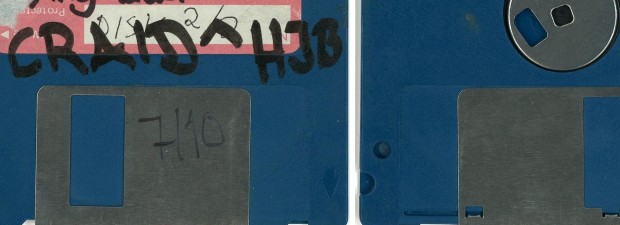
Craid/Haujobb provided us with a small batch of 17 disks from his swapping days. They stem from the mid- to late-1990s. At that time, mail swapping was on the decline due to wide-spread modem usage and the victory march of the internet. Only in Poland, where the Amiga demoscene was vibrant, yet telephone/internet costs were high, mail swapping remained the main means for sceners to exchange data. Thus, the majority of the signatures and scribblings on the disks belong to Polish Amiga scene figures, but also some names of Amiga enthusiasts in Western Europe, like Ghandy, Kure4Cancer, and Craid himself, are seen. These disks are among the most recent remnants of a vibrant culture of digital filesharing networks contructed by analogue means of communication – which existed for nearly two decades, before all-digital “filesharing networks” became the top buzzword of a new age.
CLICK:

Once again, we received some byproducts of hedning‘s C64 excavations: two stickers by the 1980s cracking group “Software of Sweden”, plus a number of C64 disk covers from the late 1980s to the mid-1990s. The disk sleeve by Case/Energy is a particular beauty – hand-drawn exclusively for his swapping partner and not just a photocopied semi-mass-product like most scene disk covers, and looking very “timeless” in a way.
CLICK:
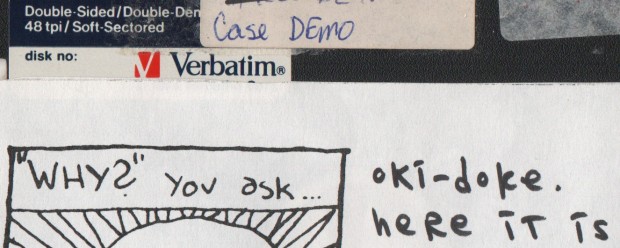
CLICK:

Thanks to Lowcola, we can present you two lost and forgotten paper magazine issues from the Finnish Amiga scene. Toilet Paper #5 and #6 both came out simultaneously in December 1991 – for reasons not completely clear. Lowcola writes: “The team had a goal of publishing 6-10 magazines, had enough material, but around December they wanted to take a holiday break, so I figure they ended up making a double issue.” The magazine was obviously not a semi-professional untertaking of the scene’s “elite”, like Illegal, Pirates, and other well-known mags, but rather the work of “average” teenage sceners. If they would have been active nowadays, they probably would have poured their desire for self-expression into a Tumblr blog or a MySpace page. One can see the the editors desperately struggling for content, filling up the space with random pictures, font samples, and rather questionable teenage humour. However, as members of the scene, they were quite well-connected. They managed to interview a member of the UK cracking group Mirage, and judging from the published readers’ letters and swapping ads, the magazine circulated as far as Turkey and South Africa.
CLICK:
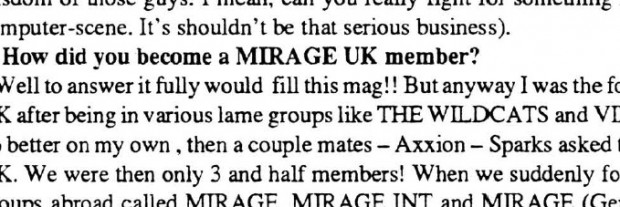
CLICK:

neat =)
wonder if the disks are still readable ;o
wonder if the disks are still readable ;o
T$: which disks, the ones from the post before? yeah they are, hedning is on it! there's the content of the title picture's disk, in fact! http://csdb.dk/release/?id=142161
Again, we managed to unearth a completely forgotten cracking scene magazine. Criminal was a papermag published by the famous C64 & Amiga group Red Sector Inc. This issue came out only two months before the group’s merger with Tristar into TRSI, an even more legendary team which is still active in today’s demoscene. According to the editorial, the mag had a precursor in early 1990 under the name Business, which had to be renamed due to a different scene magazine being published under the same name. Another note states that the “2nd issue […] will be released at some time in June”, thus one can assume that this is issue #1, even though the cover does not feature an issue number. However, to make things more confusing, Red Sector Inc. released a diskmagazine called “Criminal #1” two months earlier, in February 1990, with completely different content.
The magazine is rather slim; it appears that most of the texts were written by its two editors, Sir Mighty and Irata. Compared to many scene magazines of the time, it has a relatively “grown up” feel to it, and carries a number of copyparty reports and news items. Thanks to Hamster/TRSI, who found several pristine copies of the mag in the basement, we can present you with an extraordinary clean scan.
CLICK:
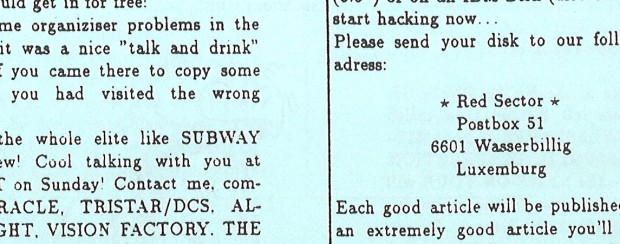
The magazine is rather slim; it appears that most of the texts were written by its two editors, Sir Mighty and Irata. Compared to many scene magazines of the time, it has a relatively “grown up” feel to it, and carries a number of copyparty reports and news items. Thanks to Hamster/TRSI, who found several pristine copies of the mag in the basement, we can present you with an extraordinary clean scan.
CLICK:

Interpersonal relations in the early cracking– and demoscene were shaped by a contradiction. On the one hand, sceners hid behind nicknames – for conspirative reasons, or just to appear “cool” and mysterious, or a mixture of both. On the other hand, despite the moral panic of “isolation” as a purpoted consequence of home computing, being part of the scene was always a highly social activity. From its dawn in the 1980s, the scene was a long-distance, yet very dense, interpersonal web, woven by floppy disks in the post, modem connections, conference calls, and intro scrolltexts. Of course, one could meet each other on a local level, and from time to time copyparties provided possibilities to meet your long-distance contacts, but more often than not you did not know how your fellow sceners outside your regional boundaries looked like.
Often sceners would sent each other photos through the post; from time to time, they would appear on the pages of papermags. Now, thanks to Hedning‘s collecting and scanning efforts, we can rediscover a long forgotten medium of photographic exchange: photo albums and flyers, compiled by swappers and spread among their contacts. A particularly industrious swapper in this regard was Incubus from Sweden, who produced dozens of such albums in the early 1990s, sharing pictures from the most recent copyparties as well as random portraits sent to him by his contacts from all over the world. These pictures, sometimes barely recognisable due to b/w photocopying, do not just show us “who was who”, but also tell a lot about self-staging and identity management in the pre-Internet years of home computer enthusiasm.
CLICK:

Often sceners would sent each other photos through the post; from time to time, they would appear on the pages of papermags. Now, thanks to Hedning‘s collecting and scanning efforts, we can rediscover a long forgotten medium of photographic exchange: photo albums and flyers, compiled by swappers and spread among their contacts. A particularly industrious swapper in this regard was Incubus from Sweden, who produced dozens of such albums in the early 1990s, sharing pictures from the most recent copyparties as well as random portraits sent to him by his contacts from all over the world. These pictures, sometimes barely recognisable due to b/w photocopying, do not just show us “who was who”, but also tell a lot about self-staging and identity management in the pre-Internet years of home computer enthusiasm.
CLICK:

thanks!
And staging with reichskriegsflagge - like silver/hitmen - is really old school.
And staging with reichskriegsflagge - like silver/hitmen - is really old school.
yeah, i was also like "wtf"...
OMG - someone found incubus photo albums. I hoped they got lost forever. ;o)
It is like Slengpung, but in black and white !
i even found incubus himself in the process... =) see his interesting comments on the albums' production in the c64/amiga scene fb group.
numtek: yeah, even the smart-ass picture comments! =)
Oh, and speaking of Slengpung: I just received permission from Incubus to put the party pictures from the albums onto Slengpung! So, what belongs together comes together =)
there we go! http://www.slengpung.com/v3/parties.php?id=652
Quote:
there we go! http://www.slengpung.com/v3/parties.php?id=652
Haha, nice one! It does belong there. Good job!
more albums to come. i've posted a slengpung news, but bitfellas didn't relay it yet.
Bodo/Rabenauge provided us with this scan. It’s an inconspicuous pink paper slip, slightly bigger than a credit card. For German crackers and demosceners in the 1980s, however, it was the single most important tool for long-distance communication and data transfer, before the introduction of BBS‘s and a long time before the Internet.
Click to read on:
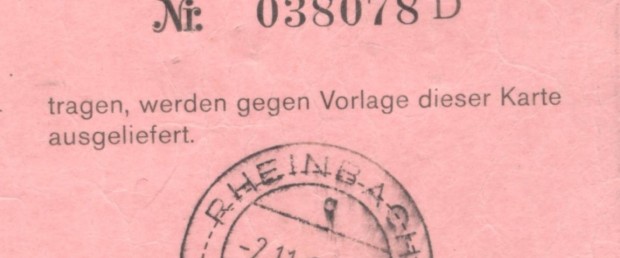
Click to read on:



